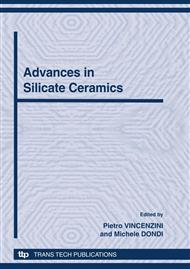p.1
p.13
p.23
p.31
p.38
p.44
p.53
p.59
p.65
The Role of the Kaolinite-Mullite Reaction Sequence in Moisture Mass Gain in Fired Kaolinite
Abstract:
Kaolinite (2SiO2.Al2O3.2H¬¬¬¬2O), an aluminosilicate mineral, is the most common constituent mineral in clay used in manufacturing traditional ceramics such as whitewares, some refractories and structural clay products. On firing, kaolin (mainly kaolinite) undergoes several phase transformations. Immediately following firing, kaolin starts to chemically combine with atmospheric moisture. This reaction causes a mass increase that is proportional to the fourth root of time. The consequence of this mass gain is an accompanying expansive strain. Kaolinite transformations following firing at a range of temperatures between 700 and 1200 oC were examined by XRD. Following firing, high accuracy mass gain measurements were carried out using a microbalance under precisely controlled conditions of temperature and relative humidity. It was found that the formation and development of crystalline phases increases with increasing firing temperature. This causes a reduction in the amorphous phase which, in turn, leads to reduced mass gain. Kaolin fired at 1200 oC exhibited the least reactivity with moisture and mullite was found to be the dominant crystalline phase after firing at that temperature. SEM was used to examine microstructural changes in the fired specimens. The reactivity of the ceramic with moisture is shown to be directly related to the crystallinity of the fired clay.
Info:
Periodical:
Pages:
38-43
Citation:
Online since:
October 2010
Authors:
Keywords:
Price:
Сopyright:
© 2010 Trans Tech Publications Ltd. All Rights Reserved
Share:
Citation:


